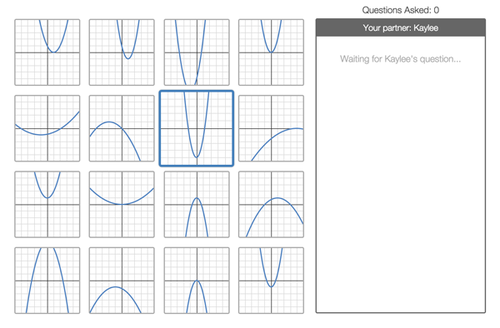Words are fun.
Words are powerful.
Vocabulary lists—for most of us—are not so much fun.
Whether it is French class (-ir verbs) or Geometry (types of triangles), most of us have memories of long lists of words out of context and feeling as though we have no hope of remembering them all, nor any purpose for doing so.
And we also know well the pleasure of having just the right word handy at just the right time—what the French call le mot juste.
We have designed Polygraph to foster the pleasure and the power of words without the drudgery of the lists.
Here is how it works.
Each student has a partner. One student is the picker, the other is the guesser.
The picker picks one thing from a set of things. Depending on the version the teacher chooses, these things might be graphs of lines, or of parabolas, or of rational functions. They might even be hexagons!
The guesser sees the same things on her screen that the picker sees on his, but scrambled to prevent location being a clue.

Here the picker has selected a graph and will soon see the guesser’s questions on the screen.
The guesser types a question. The picker can answer yes, no or I don’t know. A well written question helps the guesser to eliminate one or more options. Desmos provides the tools to keep track of questions and eliminated options.
In the next task, we ask students to analyze questions like those the class asked. We ask students, Given these two hexagons (or lines or parabolas or…), which of these questions would be the best one to ask? and The answer to this question wasn’t helpful—how can you improve the question?
Picking and guessing create the need for words—students want to describe the subtle differences they see in the mathematical objects in front of them. Sharing questions provides opportunities to spread words among students—students read how their classmates have described these differences. Whole class conversation led by the teacher helps to formalize and cement the vocabulary—the teacher can introduce the standard words that describe these same differences.
Beth Herbel-Eisenmann has studied the development of informal vocabulary in classrooms. She has described how formal mathematics vocabulary can meaningfully arise from less formal vocabulary that students use to describe mathematical objects (e.g. dented hexagons become concave; slanty-up lines have positive slope, etc.)
With Polygraph, Desmos provides tools for doing this. Words should result from a need to describe our world—this is where they gain their power. There is no better time than now to develop your students’ power of expression, so click through and set up a game of Polygraph tout de suite!
(Shout out to Brenna Magnuson, Jennifer Carlson, Mona Yusuf, Ruth Pieper and Brandon Schwab—all current or former elementary education students at Normandale Community College who helped to design the hexagons in this lesson.)
